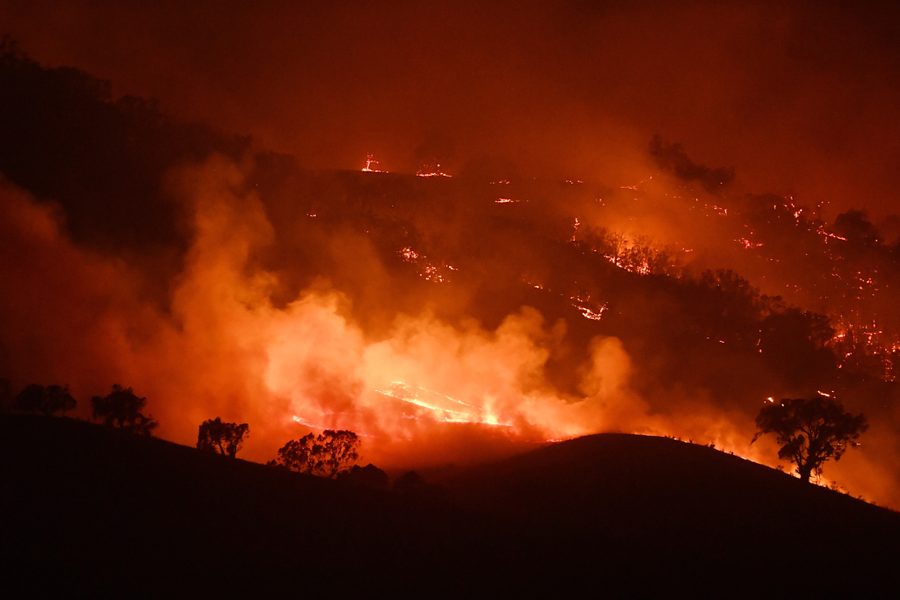Australia’s Devastating Fires Make an Urgent Case for Nationalizing Fossil Fuels
Why Australia and the United States should take over and shut down fossil fuels.
Carla Skandier

At least 33 people dead. More than a billion animals lost. An estimated 3,000 homes and over 16 million acres of land damaged or destroyed.
This is the toll, likely underestimated, of Australia’s ongoing megafires. These numbers, together with the horrifying images of thousands of carcasses of beloved Australian animals like koalas and kangaroos, tourists using masks in a smoggy Sydney Opera House, and NASA satellite images of smoke reaching as far as Chile, paint a clear image of how devastating the climate crisis can be even for privileged nations.
It’s also pushing Australians to face the need to part ways with what they have been told is an essential fuel for their economic growth: coal. The continent’s best — and perhaps only — option for doing so may also be its most radical: Nationalize the coal industry to shut it down.
Australia’s wildfires, already more than six times greater than California’s 2018 fires, have been directly linked to record levels of hotter and drier weather — conditions that are expected to be the new normal as we continue to burn coal in an already carbon-constrained atmosphere. Yet, Australian Prime Minister Scott Morrison has been reluctant to recognize the connections between the country’s ravenous coal production and consumption—coal supplies 60 percent of Australia’s electricity and generates 3.5 percent of Australia’s GDP just in exports — and the destruction his nation is facing. Instead, Mr. Morrison keeps putting forward a focus on job security and economic stability that fronts for a pro-coal agenda.
Yet the record-smashing bushfire season is showing that climate inaction is, in fact, the greatest threat to Australia’s decades-long economic boom. The megafire and the drought that preceded it are harming the country’s tourism and agriculture, two major sectors of Australia’s economy. The fires have also started rippling through the insurance industry, with initial claims surpassing a half-billion Australian dollars, a number expected to increase as events continue to unfold. Even Australia’s strong coal industry is, ironically, at risk. BHP, the world’s largest mining company and 19th biggest greenhouse gas contributor, recently reported that smoke and dust from this season’s fires have slowed the coal production of its New South Wales’s power plant and mine by 11 percent.
Financial experts are increasingly worrying that the fires might as well be the event that will push Australia’s economy, which performed relatively strongly during the 2008 financial meltdown, toward the unknown territory of a 21st century economic depression. The mother of all central banks, the Bank of International Settlements (BIS), warned in a new report that the climate emergency is putting worldwide economies’ stabilities at risk and might well be the driver of the “next systemic financial crisis.” The report argues that once that happens, central banks might have no other choice than to act as “climate rescuers of last resort.” Just as during the 2008 financial crisis, when central banks used their monetary power to clean the troublesome balance sheets of systemically critical corporations by injecting money and removing bad assets, these banks might need to intervene once again to get financial toxins — this time in the shape of fossil-fuel assets — out of the economic system. That would mean, in Australia’s case, the country’s climate-change-driving coal mines and generation facilities.
The idea of a 2008-like financial intervention as a way to deal with fossil-fuel stranded assets — assets that won’t be exploitable to provide investors the expected returns — is not a foreign concept. Yet, it still fails to tackle the climate crisis head on. More than saving Australia’s financial system from toxic coal assets through a rerun of 2008 U.S. bailouts, the Reserve Bank of Australia (RBA) should make sure that any rescue is married to the actual wind down of companies’ coal production. This is necessary not only to secure the country’s financial stability, but to address a rapidly expanding demand among Australians for the government to lead on climate action — which must include putting to rest any ambition to expand BHP, Adani, and companies alike dirty coal fleet and retire at least one coal unit per day.
What is happening in Australia should be seen as a cautionary tale for the United States. Both countries share more in common than pro-fossil fuel personnel heading their Administrations, while simultaneously being hit by new realities of destructive storms and wildfires. Over the past four decades Americans experienced 258 weather and climate events that surpassed the billion dollars benchmark, costing Americans over $1.75 trillion. Wildfires in California and Alaska in 2019 accounted for $4.5 billion of those losses. The two countries also share the shameful records of being among the world’s top fossil fuel exporters; Australia as the second leading coal exporter, and the United States on track to compete for the top one oil exporter position within the next five years.
This masterful continued expansion of fossil fuels paired with increasing climate damages make these countries stand as front runners for facing the next financial crisis — this time driven by fossil fuel bad assets. In 2013, London-based organization Carbon Tracker issued a report exposing that Australia could face a 44 percent decrease in its coal revenues under a 2° Celsius scenario; a decline that, according to my assessment, must be even sharper in order to achieve the 1.5° Celsius target. In that same year, Carbon Tracker also pointed to the fact that the United States is in a particularly precarious position, with the New York Stock Exchange ranking as the stock market with the highest concentration of fossil fuels in their exchanges. As the climate emergency becomes more pressing, any event can be the tipping point in exposing the real value of fossil fuel assets and start a shockwave throughout the countries’ markets.
The chaos Australia is now facing exposes the need for stronger government interventions to avoid the many threats fossil fuel toxic assets now impose on society — in particular the need for the nationalization of the coal industry to rapidly decline its production. Just like the RBA is heading to a point when it will be “the only game in town,” soon will the Federal Reserve be the one as well. Instead of waiting for a catastrophic event and further destruction to act on climate, the U.S. government should take the lead and look at the events unfolding below the Equator line as lessons to why the nationalization of the nation’s oil, gas, and coal industry should be done now; not after companies like ExxonMobil and Chevron have poured another $260 billion in new oil and gas fields. If not for the well-being of its own people, then for the sake of the American and Australian economies.

I hope you found this article important. Before you leave, I want to ask you to consider supporting our work with a donation. In These Times needs readers like you to help sustain our mission. We don’t depend on—or want—corporate advertising or deep-pocketed billionaires to fund our journalism. We’re supported by you, the reader, so we can focus on covering the issues that matter most to the progressive movement without fear or compromise.
Our work isn’t hidden behind a paywall because of people like you who support our journalism. We want to keep it that way. If you value the work we do and the movements we cover, please consider donating to In These Times.




